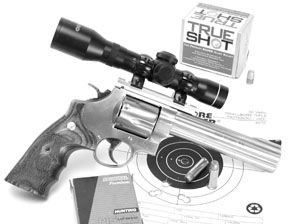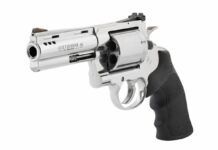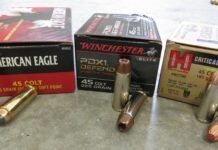
In the last two years a number of very powerful handgun cartridges have found increasing favor among shooters. Ballistic dynamos such as the .454 Casull, .475 Linebaugh, and the .480 Ruger are now available to the hunter who wants to be a heavy hitter. Some people have a genuine need for a weapon with the portability of a handgun and the power of a rifle. Some are handloaders who recognize the flexibility of revolver cartridges that offer tremendous headroom. Of course, there will always be the shooters who merely like the biggest firecracker they can find. But for most people, the .44 Magnum cartridge is enough.
In this test we take a look at two new .44 Magnum revolvers and compare them to the latest top-of-the-line Smith & Wesson 629, the Classic DX. Our newcomers include the .44 Magnum addition to Taurus’s Raging Bull lineup, which like the Smith & Wesson revolver, offers double and single action play. Our third gun is a single-action revolver from Sturm, Ruger and Company, the Super Blackhawk Hunter. This is Ruger’s newest magnum, so we felt re-testing the double action Redhawk again at this time would be redundant. Furthermore, since few hunters shoot double action in the field, our test was conducted in single-action mode anyway.
Range Session
Although our Smith & Wesson came with a test target displaying a group fired from 25 yards, we decided to test at 50 yards instead. It is a widely held opinion that hunting with pure handgun cartridges (not rifle cartridges in handgun frames) should only include game engaged at a range of 50 yards or less. So, in our opinion the results we obtained should illustrate a fair approximation of the weapon’s true practical capability. We tried firing groups prone, but subsequently found it more practical to shoot from a bench. That our data was collected from a sandbag rest echoes how the guns should be shot in the field; that is, they should be fired supported using a tree limb, treestand bag, the window of a stand, or even a backpack placed on a rock. We also chose to shoot with a scope, an inexpensive two-power (2x22mm) model from Tasco. Any more than 2X and the reticle can really start to dance, especially in a long-relief model. The inconvenience was remounting the scope from gun to gun. The Ruger would only accept its supplied rings, and when moving the scope from the Smith & Wesson to the Taurus mount, the rings had to be repositioned on the scope’s tube. So each time an inordinate amount of work was needed to zero the scope. Each gun was weighed as tested, meaning with the scope mount in place and rear sight removed. The Ruger and Taurus guns, however, didn’t require the rear sight to be removed.
Our choice of ammunition included two 240-grain rounds. One was the Federal American Eagle jacketed hollow point (JHP) and the other a jacketed soft point (JSP) from the Winchester USA (white box) line. We added one lead round from Federal, Castcore, weighing 300 grains that was meant to penetrate and then allow the core to move deeper with greater impact. This cartridge did offer us valuable insights into each gun’s preference, or lack of same, for lead bullets.
Ruger Super Blackhawk Hunter (KS-47NHN), $639
With the success of the New Model Blackhawk series fresh in our memory (September 2001 and January 2001), we couldn’t wait to test the .44 Magnum Hunter. This is a very sleek gun, reminiscent of the much more expensive revolvers from Freedom Arms.
The single-action Hunter has a number of personalities. The addition of an integral scope mount into the handsomely sculpted top strap begs to be fitted with a scope and taken into the field. But the Hunter has its Wild Wild West side as well. We’re not sure if this gun will qualify for the Modern Division of Cowboy Action shooting, but it would be fun to try. For this use, we would recommend .44 Special or downloaded magnum rounds. With its round, short grip frame, the gun easily rides up and presents the hammer to the thumb between shots. With light loads aboard, we were pleased how quickly and easily this gun could be fired one handed.
But Sturm, Ruger & Co. named this gun the Hunter, which would direct us to evaluate it as a field weapon. We think the vertical dimensions were kept compact, to make it easier to pack than either the S&W or the Taurus. Of course, much less framework is necessary for a single-action mechanism.
Our main complaint with this gun is the short grip. From the bench the top finger of our weak hand often made too much contact with the bottom of the trigger guard. For a time we were not sure what to do with our left hand. The only way to solve this was to replace the supplied wood-laminate grip (good-looking but slippery). Pachmayr’s model 3137 Presentation grip is a good way to go. It increases the grip length and circumference, making this a more comfortable two-handed gun to shoot and hold. This is a desirable upgrade since our Super Blackhawk Hunter produced the most muzzle energy of the test, firing the Federal 300-grain Castcores for an average of 1160 foot-pounds of force. One other source of discomfort was the edges of the track just above the ejector rod pad. These edges eventually wore a stinging pair of slices into the tip of our finger.
Operation of the Hunter was standard procedure. No half-cock or loading notch is necessary because simply swinging open the loading gate takes care of freeing the cylinder to rotate. On the Ruger Hunter, we noticed that when positioning the cylinders for unloading, lining up the chambers has become more predictable because of a clicking sound as the mouth of each chamber comes into view. We liked the square top strap, and the Hunter comes with a set of rings for easy, precise mounting of a tubular scope. For those preferring an electronic dot or reticle scope such as the rugged Bushnell Holosight, a Weaver base would need to be added, which Weigand Combat does for $49.95 ([570] 868-8358).
In terms of accuracy, our revolvers were capable of printing a five-shot group measuring under two inches at 50 yards. However, in the case of the Ruger Blackhawk Hunter, the gun would not respond to the Winchester 240-grain jacketed soft points. But the gun shot the Castcores well.
Encouraged by this performance we went ahead and tried some handloads featuring Alliant 2400 powder and a variety of lead slugs from Oregon Trail, (800) 811-0548. With new True Shot silver alloy bullets running at similar velocities to our factory test ammunition, the Ruger really began to shine. The True Shot bullets slid out of the guns easier, so using a smaller amount of powder compared to loading jacketed bullets helped reduce recoil. This also made the wood grip easier to live with.
Taurus .44 Magnum Raging Bull, $575
When we tried one of Taurus’s original Raging Bulls chambered for .454 Casull, we judged it to be the most comfortable of factory-built Casull guns to shoot. This was because of the weight and also the porting system. In the case of the .44 Magnum Bull, we feel it is more weight than porting.
While the overall length of the Raging Bull is similar to the Smith & Wesson, the barrel is actually almost an inch shorter. (This model is also available with an 8.4 inch length barrel.) The area beneath the ports is an expansion chamber. One can see the crown of the barrel, marking where the rifling ends, from the front of the gun. In watching the gun fire, we felt the expansion chamber was letting too much of the gases escape forward instead of upwards through the ports as intended. Still, the Taurus was again the most comfortable of our test trio to shoot. Some of this was because of the weight anchored by the healthy underlug, not to mention the extra mechanism such as a second crane lock. Taurus borrows from Dan Wesson with a latch on the crane itself, forward of the cylinder and also a lockup point at the tip of the ejector rod.
This is a very large-framed revolver, and the grip is augmented at the backstrap, making it feel even larger. We didn’t mind its size when firing single action even if the length of pull is at the edge of acceptable for medium to large sized hands. Big people should really like this arrangement, but for most an alternate grip is necessary to even consider double action shooting.
The supplied sights are very good, mainly because of the plain black Patridge sight up front. Had we attempted our test with open sights only as supplied, we would have judged the Taurus to have one of the best sight pictures. The Smith & Wesson 629 DX comes a variety of front blades, but we would have chosen to use the plain Patridge just like the one on the Taurus. To mount a scope, we opted for the Taurus optional sight-rail that was also designed by American Pistolsmith Guild President, Jack Weigand. The underside mates squarely with the top strap held in place with three tabs that fit through the venting. There is no need to remove the rear sight to mount this base, but we learned this only after removing the rear sight assembly by releasing the elevation screw and punching out the retaining pin.
Our Raging Bull also chose the lead-topped rounds as its most accurate load, delivering an average of only 1.9 inches firing the 300-grain Castcores. Performance was mostly even across the board, with groups just above 2 inches fairly common. Lower-powered loads such as .44 Special that we used during break-in were not as consistent, however. We think the .44 Magnum Taurus will appeal to buyers who are looking for something a little different.
Smith & Wesson 629 Classic DX, $860
Although it was close, the Classic DX produced the highest overall velocity, pumping out the Federal American Eagle 240-grain JHP at 1398 fps. This equates to muzzle energy of 1042 foot-pounds.
What does it feel like behind the grip of the 629 with this much power coming out the front? Even though this model comes with a choice of grips, as well as a choice of front sight blades, no matter which one we chose we felt the most impact in the palm just below the pad of the index finger. Both the wood two-piece grip and the rubber Hogue Monogrip offer an open backstrap to reduce length of pull, and that is where backward energy combines with muzzle flip to produce discomfort. While this revolver is second best in terms of absorbing recoil, if it is results you are after, you’ll find a way to adapt.
It didn’t matter what we shot in the 629 DX Classic; accuracy was assured. We changed grip and we changed ammunition. We didn’t shoot a single group larger than 1.9 inches. The lead was best, but only 0.2 inch on average.
Another feature we liked in the 629 was the way we were able to set it up for a scope. The rear sight came off with one screw, and unlike the Taurus and Ruger, a baggy was not needed to keep together loose parts such as springs or roll pin. The scope mount cost only $6.30 from Brownells (part number 955-481-010). Today’s Smith & Wesson revolvers come drilled and tapped under the rear-sight assembly, so the base went on in seconds, and it was more secure than the units we used for the Taurus, in our view. We already know the S&W’s potential for a smooth DA trigger, so that’s a plus. Also, the 629 N-frame revolver has been around a long time, and there are many aftermarket parts for it.
The price of the Classic DX is higher than its competitors because it comes with optional equipment such as the grips and front sight blades. These blades range in design from a black serrated ramp to a black serrated ramp with orange insert (standard). In between is a flat Patridge, a Patridge with white inlaid dot, and one more Patridge with gold-stud dot. This last style dates back to speed and aerial trick shooters such as Ed McGivern (see the book Fast and Fancy Revolver Shooting). The standard 629 Classic is some $90 less, putting it inside the range of the two competitors tested here. The difference in price, after adding a scope mount to the Taurus or to the 629, is one form of equalizer, but since the Ruger comes with a set of scope rings, the Ruger ultimately wins the price battle. Both the Taurus and Smith & Wesson revolvers come with a key-operated hammer lock, and like the Raging Bull, the 629 models are also available with an 8.4-inch barrel.
Gun Test Recommends
Ruger Super Blackhawk Hunter, $639. Buy It. We felt it odd that such a powerful weapon would be built so much like a cowboy-action dueling gun. Once we found that Pachmayr’s rubber grip made full power loads easier to handle and it had a distinct preference for lead bullets, we really began to enjoy this revolver.
Taurus .44 Magnum Raging Bull, $575. Buy It. We felt the Bull’s weight alone killed recoil enough, and the porting cost the gun extra rifling it could have used. Lower-velocity rounds seemed prone to flyers. A smaller grip would add control for most hands and make double-action operation more feasible.
Smith & Wesson 629 Classic DX, $860. Our Pick. The 629 Classic DX covered the most bases in terms of accuracy. And it’s likely that you wouldn’t see a downgrade in performance by purchasing the cheaper plain 629.
Also With This Article
[PDFCAP(5)]




























